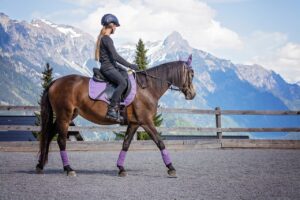 Embarking on a journey into the world of horse riding can be both exhilarating and rewarding. As a beginner in the English style of riding, acquiring a solid foundation of essential techniques is key to building confidence, ensuring safety, and establishing a harmonious connection with your equine partner. In this article, we’ll guide you through the fundamental riding techniques that every rider should master, setting you on the path to becoming a skilled and confident equestrian.
Embarking on a journey into the world of horse riding can be both exhilarating and rewarding. As a beginner in the English style of riding, acquiring a solid foundation of essential techniques is key to building confidence, ensuring safety, and establishing a harmonious connection with your equine partner. In this article, we’ll guide you through the fundamental riding techniques that every rider should master, setting you on the path to becoming a skilled and confident equestrian.
1. Correct Riding Posture: The Foundation of Balance
Achieving the correct riding posture is the cornerstone of successful riding. Start by aligning your body in a straight line from ear to shoulder, hip, and heel. Keep your heels down, maintaining a slight bend in your knees. Engage your core muscles to support your posture and keep your back straight but relaxed. This balanced posture allows you to communicate effectively with your horse through subtle cues.
2. Balanced Seat: Connecting with Your Horse
Your seat plays a crucial role in communicating with your horse. Achieve a balanced seat by evenly distributing your weight across your seat bones. Sit deep in the saddle, feeling your horse’s movement beneath you. Engage your seat muscles to follow the rhythm of your horse’s walk, trot, or canter. A balanced seat fosters harmony between rider and horse, making communication more precise.
3. Effective Rein Aids: Guiding Your Horse
The English riding style relies on precise rein aids to communicate with your horse. Hold the reins softly but firmly, allowing your horse to feel your presence. To turn left, apply gentle pressure with your left rein while maintaining a slight contact with the right rein. The opposite applies for turning right. Practice using direct and indirect rein aids to guide your horse accurately and smoothly.
4. Leg Aids for Impulsion and Direction
Your legs are essential tools for communicating impulsion and direction to your horse. Keep your legs relaxed and close to your horse’s sides. To ask your horse to move forward, apply gentle pressure with both legs. If you want your horse to turn, apply pressure with your inside leg behind the girth and support with the outside leg. Combining leg aids with rein aids helps you achieve effective communication and control.
5. Half-Halt: Balancing and Regaining Attention
Mastering the half-halt is a pivotal technique in riding. It’s a subtle aid that helps rebalance your horse, gather impulsion, and regain their attention. To execute a half-halt, close your fingers on the reins, engage your seat, and gently squeeze with your legs. This communicates to your horse to slow down or rebalance without stopping completely.
Conclusion:
As you embark on your journey as a beginner in riding, remember that mastering these essential riding techniques takes time, patience, and practice. Building a strong foundation in correct posture, balanced seat, effective rein and leg aids, and the art of the half-halt will set you on a path to becoming a skilled and confident rider. By continuously refining these techniques and forging a strong connection with your horse, you’ll not only enjoy the thrill of riding but also build a bond that can last a lifetime. Happy riding!